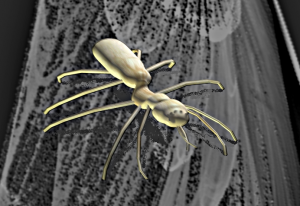BY LETTER
Trees (Garden World)
Galactography > Regions of Space > Middle Regions/Hinter-regions
Galactography > Systems and Worlds > Systems & Worlds S - T
Science > Biology > Xenobiology
Galactography > Systems and Worlds > Systems & Worlds S - T
Science > Biology > Xenobiology
Garden World in the Middle Regions, famous for its ultra-tall trees | |
 Image from Steve Bowers | |
| Trees has many shallow seas and numerous islands, formed after the largest continent began to break apart 50 million years ago. | |
Trees - Data panel | |
| System: | HD 47186, HIP 31540 |
|---|---|
| Stellar Type: | G6 V |
| Luminosity: | 1.19 x sol |
| Region: | Inner Middle Regions, Constellation Canis Major |
| Colonised | 2033 AT |
| Distance from Sol | 121.9 ly |
| Planets | 1: Clouds: Orbital distance: 0.05 AU Orbital period: 4.08 standard days Mass0.07 x Jupiter Radius 25823 Type Hot Neptune. .. 2: Vapours: Orbital distance: 0.394 AU Orbital period: 0.241 standard years Mass 3 x Earth Radius 8901 km Type Superterrestrial. .. 2: Rocks: Orbital distance: 0.66 AU Orbital period: 0.523 standard years Radius 2112 km Type Hermian. .. 4: Trees: Orbital distance: 1.1 AU Orbital period: 1.11 standard years Day length: 26 hours Radius 0.89 x Earth Mass 0.68 x Earth Surface Gravity 0.87 gees Type Garden World. .. 5: Storms: Orbital distance: 2.395 AU Orbital period: 3.7 standard years Mass 0.35 x Jupiter Radius 49823 Type Eujovian. .. 6: Dust: Orbital distance: 4.02 AU Orbital period: 7.8658 standard years Radius 1563 Type LithicGelidian |
 Image from Steve Bowers | |
| The planets of the HD 47186 system: Trees, Clouds, Storms, Vapours, Rocks and Dust (not to scale) | |
Introduction and Quick Facts
One of the first Earth-like natural biospheres encountered.Named after the gigantic trees that grow on most land and in the shallow seas, creating a complex vertical ecosystem. The planet has a noticeably low gravity, and many plants exploit hydrogen-filled bags to rise as high as possible. Forest fires (made especially dramatic by the bags and high oxygen content of the atmosphere) are common and important for the renewal of the ecosystem. The Tree clade of tweaks (descended from several megacorp colony expeditions) have adapted to a brachiating or flying lifestyle, some variants also including a resistance to fire.
History
The various nations and alliances that govern Trees have never played a major political role, and the weak defences have made it an easy prey for different powers. From the beginning it was controlled by a succession of megacorps, until it became part of the Conver Ambi. A popular folk hero from the time of the Conver Ambi occupation is Erle Spang, a canopy-dweller who led a series of rebellions on the continent of Tilia, which led to the establishment of a free zone in defiance of the world cybercouncil.When the Conver Ambi split, it became part of the Sophic League. For over 2000 years it was to a large extent a nature preserve, until a majority of the population voted to join the NoCoZo and became a protectorate of Automated Defense Systems Inc.
Rising tourism and biotech industry led to a local boom, and in the late ComEmp era Trees successfully made itself independent for a time, until 7433AT when the voters chose to join the Zoeific Biopolity rather than become a Caretaker Protectorate. In the Current Era the system has again become independent, but throughout its long history the population of this biologically rich world have always taken their various external rulers less seriously than most.
Skywracks
Image from Steve Bowers | |
| Skywracks are tall trees on this planet which mostly obtain water from rainfall rather than via their roots | |
Seed-pods are used in crafts and decoration by the locals, as gourds, or carved into various forms - the largest are hollowed out into one room dwellings, called plakts.
The equatorial region has two seasons - an extended wet season when growth occurs, and a dry season. Every so often - once in a few decades due to a combination of solar cycles and ocean circulation, the rains fail to materialise, or they don't come where they should, and everything becomes tinder dry. The local tweaks call this 'Tlek Preh', or the Burning Season.
Pspyders
 Image from Steve Bowers |
Other species on this world include Barkbats, Honeywhips and Sailfins.
Related Articles
Appears in Topics
Development Notes
Text by Anders Sandberg
Updated by Steve Bowers 2020
Initially published on 22 April 2004.
Edited by The Astronomer 2024-07-14 to correct stellar type of HD 47186.
Updated by Steve Bowers 2020
Initially published on 22 April 2004.
Edited by The Astronomer 2024-07-14 to correct stellar type of HD 47186.






